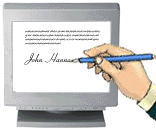

President Signs Electronic Signatures Act
 On
June 30, 2000, President Clinton signed into law the Electronic Signatures
in Global and National Commerce Act. It had passed with overwhelming support
from both parties in both Houses.
On
June 30, 2000, President Clinton signed into law the Electronic Signatures
in Global and National Commerce Act. It had passed with overwhelming support
from both parties in both Houses.
In an Internet Webcast
the next day, the President said that the almost unlimited potential in
the longest economic expansion in our history is "being held back, ironically,
by old laws written to protect the sanctity of contracts." These laws
require pen-and-ink signatures on paper documents for contracts to be
enforceable.
The new legislation
means that on-line contracts will now have the same legal force as equivalent
paper ones, he said. "Companies will have the legal certainty they need
to invest and expand in electronic commerce. They will be able not only
to purchase products and services on-line, but to contract to do so. And
they could potentially save billions of dollars by sending and retaining
monthly statements and other records in electronic form. Eventually, vast
warehouses of paper will be replaced by servers the size of VCRs.
"Customers will soon enjoy a whole new universe of on-line services. With the swipe of a smart card and the click of a mouse, they will be able to finalize mortgages, sign insurance contracts, or open brokerage accounts.
"Just as importantly, the law affords consumers who contract on-line the same kinds of protections and records, such as financial disclosures, they currently receive when they sign paper contracts. Consumers will be able to choose whether to do business and receive records on paper or on-line. They will have the power to decide if they want to receive notice and disclosures electronically. It will not be their responsibility, but the company's, to ensure that the data sent to a consumer can be read on the consumer's computer. No more e-mail attachments with gibberish inside.
"Finally, government agencies will have the authority to enforce the laws, protect the public interest, and carry out their missions in the electronic world.
July 1, 2000
The President's Webcast was made from Independence National Historical Park in Philadelphia.